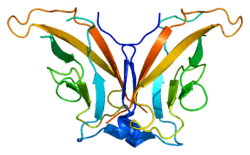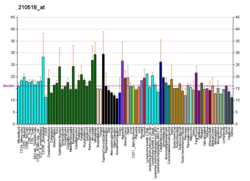CDH8
Cadherin-8 is a protein that in humans is encoded by the CDH8 gene.[5][6][7]
Function
This gene encodes a type II classical cadherin from the cadherin superfamily, integral membrane proteins that mediate calcium-dependent cell-cell adhesion. Mature cadherin proteins are composed of a large N-terminal extracellular domain, a single membrane-spanning domain, and a small, highly conserved C-terminal cytoplasmic domain. The extracellular domain consists of 5 subdomains, each containing a cadherin motif, and appears to determine the specificity of the protein's homophilic cell adhesion activity. Type II (atypical) cadherins are defined based on their lack of a HAV cell adhesion recognition sequence specific to type I cadherins. This particular cadherin is expressed in brain and is putatively involved in synaptic adhesion, axon outgrowth and guidance.[7]
Clinical significance
Disruptions of CDH8 in humans have been implicated in autism.[8][9]
References
- GRCh38: Ensembl release 89: ENSG00000150394 - Ensembl, May 2017
- GRCm38: Ensembl release 89: ENSMUSG00000036510 - Ensembl, May 2017
- "Human PubMed Reference:". National Center for Biotechnology Information, U.S. National Library of Medicine.
- "Mouse PubMed Reference:". National Center for Biotechnology Information, U.S. National Library of Medicine.
- Kremmidiotis G, Baker E, Crawford J, Eyre HJ, Nahmias J, Callen DF (May 1998). "Localization of human cadherin genes to chromosome regions exhibiting cancer-related loss of heterozygosity". Genomics. 49 (3): 467–71. doi:10.1006/geno.1998.5281. PMID 9615235.
- Suzuki S, Sano K, Tanihara H (Apr 1991). "Diversity of the cadherin family: evidence for eight new cadherins in nervous tissue". Cell Regulation. 2 (4): 261–70. doi:10.1091/mbc.2.4.261. PMC 361775. PMID 2059658.
- "Entrez Gene: CDH8 cadherin 8, type 2".
- Pagnamenta AT, Khan H, Walker S, Gerrelli D, Wing K, Bonaglia MC, et al. (Jan 2011). "Rare familial 16q21 microdeletions under a linkage peak implicate cadherin 8 (CDH8) in susceptibility to autism and learning disability". Journal of Medical Genetics. 48 (1): 48–54. doi:10.1136/jmg.2010.079426. PMC 3003876. PMID 20972252.
- Brandler WM, Antaki D, Gujral M, Noor A, Rosanio G, Chapman TR, et al. (2016). "Frequency and Complexity of De Novo Structural Mutation in Autism". The American Journal of Human Genetics. 98 (4): 1–13. doi:10.1016/j.ajhg.2016.02.018. PMC 4833290. PMID 27018473.
Further reading
- Tanihara H, Sano K, Heimark RL, St John T, Suzuki S (Apr 1994). "Cloning of five human cadherins clarifies characteristic features of cadherin extracellular domain and provides further evidence for two structurally different types of cadherin". Cell Adhesion and Communication. 2 (1): 15–26. doi:10.3109/15419069409014199. PMID 7982033.
- Kido M, Obata S, Tanihara H, Rochelle JM, Seldin MF, Taketani S, Suzuki ST (Mar 1998). "Molecular properties and chromosomal location of cadherin-8". Genomics. 48 (2): 186–94. doi:10.1006/geno.1997.5152. PMID 9521872.
- Shimoyama Y, Tsujimoto G, Kitajima M, Natori M (Jul 2000). "Identification of three human type-II classic cadherins and frequent heterophilic interactions between different subclasses of type-II classic cadherins". The Biochemical Journal. 349 (Pt 1): 159–67. doi:10.1042/0264-6021:3490159. PMC 1221133. PMID 10861224.
- Blaschke S, Mueller CA, Markovic-Lipkovski J, Puch S, Miosge N, Becker V, Mueller GA, Klein G (Oct 2002). "Expression of cadherin-8 in renal cell carcinoma and fetal kidney". International Journal of Cancer. 101 (4): 327–34. doi:10.1002/ijc.10623. PMID 12209956.
External links
- CDH8 human gene location in the UCSC Genome Browser.
- CDH8 human gene details in the UCSC Genome Browser.
- Overview of all the structural information available in the PDB for UniProt: P97291 (Mouse Cadherin-8) at the PDBe-KB.







